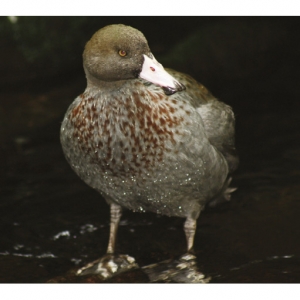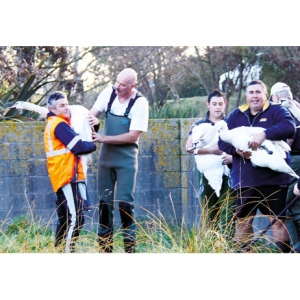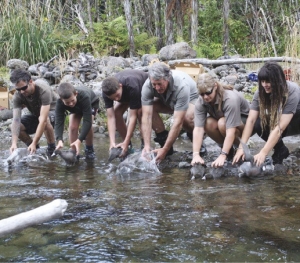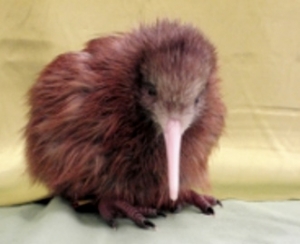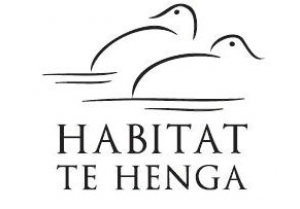Displaying items by tag: Release
Captive breeding keeps up Whio numbers
Peter Russell keeps a watchful eye on Whio to make sure the numbers are kept up and they return as much as possible, to the areas where they started life.
Breeding Results
The past year has been the best to date with 26 ducklings reared and released back into the wild. This was achieved by three pairs, the Auckland pair produced 11, the pair at Peacock Springs having 10 and the Orana pair five. These pairs had all been flock mated. Both the Auckland and Peacock pairs did double clutch which really helps with numbers produced.
Three pairs at Hamilton, Palmerston North and Staglands that I was hoping would produce, did nothing. I hope they do better in the coming season.
Flock Mating
This season we have flock mated four more pairs that gives pairs to Otorohanga, Mt Bruce, Queenstown and another pair at Peacock. I was a bit disappointed with Mt Bruce who took so long in sending male birds to Peacock that the female in the new pair at Peacock laid a clutch of eggs without a male.
It was also disappointing that no wild clutches came in last season to keep on making up more pairs for captive population.
Releases
The first release of 10 was at Egmont National Park on the January 29 with Andrew Glaser of DoC coming over and taking staff through putting transponders in and a video team taking footage of this and the release. We had a group of school children who attended and Andy was in his glory.
The second release was on the Manganui-a-te-ao and it was good to see Alison Beath also of DoC come down to put the transponders in. We released a total of eight birds with two older birds which came from there as juveniles and have only bred once and hadn’t done anything for the last three years. It was a great day. Lots of school children.
The third release was on the Tongariro which also went really well with lots of people and Genesis staff involved. Six birds were released. The last release was back at Egmont on a Saturday so their volunteers could attend as most of them work during the week. There were four birds plus a duckling I had hand reared and then sent to Peacock Springs so it would be brought up with other birds.
It has been so much better now with Air New Zealand sponsorship for moving ducks about and saving costs on breeders and Peacock Springs when sending for release. It is a bit more work for me but it goes with the job.
Quality
Duckling quality is very good and I am sure that the matting’s we are doing with eggs that are coming in is paying off with a very good bird for release.
Deaths for the year
There were seven deaths during the year. Two were neonatal and one a 20-year-old male and another 19-year-old male. We also lost 15 males including one eight-year-old. These males were not in the breeding programme.
The breeding male from Auckland Zoo died after a very good first season. The female is now at Mt Bruce and has been flock mated with the surplus wild males.
Pairs still needed at: 1. Nga Manu, 2. Mt Bruce, 3. Peacock Springs, 4. Kowhai Aviary, 5. Willowbank, 6. Auckland Zoo, and 7. Ron Munro. We need to bring in more clutches this coming season. Releases for next year Egmont wants to carry on releasing next season though we still need to look for new sites. Also returning birds to areas were the clutches of eggs are from.
Catching up the swans
There is something majestic about Mute swans as they glide gracefully on the surface of a lake, no wonder they are in great demand.
Swan Upping* has been an annual event for Ducks Unlimited for about 28 years with some members travelling quite a distance to take part in “catching up the swans”.
Peacock Springs, now The Isaac Conservation and Wildlife Trust donates Mute swans to DU, and the swans contribute a major amount to DU’s yearly fund raising.
This year Ross Cottle and Jim Campbell brought seven swans north. Back in the North Island they collected all the birds that DU members have reared (in total 17) and they were taken to Ross’s place in Masterton to sort into breeding pairs for distribution to members who want them.
Catching the swans is called Swan Upping short for catching up the swans.
Two Cape Barren Geese were caught up in this event. They are Grey Geese native to the southern coast of Australia called Cape Barren. They have black feet, pink legs, a blue grey body and lime green beak. They have gone to long time DU member Mike Burke in northern Manawatu.
*Swan Upping is an annual ceremonial and practical activity in Britain in which Mute swans on the River Thames are rounded up, caught, marked, and then released.
Traditionally, the Monarch of the United Kingdom retains the right to ownership of all unmarked mute swans in open water, but only exercises ownership on certain stretches of the river and its surrounding tributaries. This dates from the 12th century, during which time swans were a common food source for royalty. Swan Upping is a means of establishing a swan census and today also serves to check the health of swans.
Photos: Catherine Ott, Peacock Springs.
To save Pateke
To save Pateke Knowledge, care and endurance
Positive aspects of the recovery programme
1. Flock mating/natural pairing of Pateke was the key to the highly successful captive breeding programme – together with the enthusiasm of participants. Flock mating is now being used in a number of rare waterfowl recovery programmes.
2. Captive reared brown teal adapt readily to a wild environment, natural or created.
3. In Northland captive reared Pateke released at Mimiwhangata, Whananaki and Purerua between 1986-1992 survived for long periods and produced offspring – in spite of little predator control, with predator control Pateke are doing well.
4. Where predator control programmes have been in operation at suitably selected quality release sites in Northland (and more recently on the Coromandel) Pateke have survived very well and have successfully reared many progeny.
5. In the absence of waterfowl hunting and predators, captive reared brown teal released into quality Pateke habitat have few problems adapting to the wild.
6. A gradual transition from captive bred to wild, using pre-release pens and a supplementary diet was successful.
7. Brown teal are by far the most predator vulnerable species amongst all species of waterfowl
8. Captive reared teal released on off-shore islands that have suitable predator-free habitat survive and breed well.
9. When the release of captive reared Pateke into quality habitat is coupledwith predator control, a pre-release aviary, supplementary feeding and with the site having an adequate area for a significant population increase (such as at: Mimiwhangata, Purerua and Port Charles), the recovery process is a very simple one!
10. Between 1969-1992 it was learnt that releasing captive reared Pateke at a large number of unsuitable and disconnected habitats, with 35 different sites being used, achieved little, was counterproductive and very expensive.
11. Since the 2000 Audit of the recovery programme steady progress has been made towards increasing the wild populations of Pateke.
Starting in 2009 a150 captive reared Pateke have been released in Fiordland, but it is too early to predict the outcome of this programme.
Pateke were once widespread throughout Fiordland, the habitat is still excellent and with ongoing predator control a South Island population could be re-established.
The 2000 audit of the pateke recovery programme
Recovery mode
The recovery on the Coromandel clearly endorses the philosophy that provided Pateke have suitable habitat, protection from predators and ongoing management support they will survive and breed very successfully, with the success on the Coromandel possibly being the most rapid recovery of an endangered duck.
Negative aspects of Recovery programme
Between 1975 and 2002 there were 2000 Pateke released into mainland wetland sites, with all releases failing to slow the species decline, largely due to:
• Lack of continuity amongst Pateke management personnel and others directly involved in planning the survival of Pateke.
• Sites used were poorly selected.
• No pre-release study to see if there was an adequate food source.
• No pre-release study to determine whether the habitat was suitable.
• Little predator control and little knowledge of the subject.
• Little understanding about the main predators to control/ eliminate.
• Until early 2000 no sites had ongoing predator control.
• Many sites were out on a limb, with no wild Pateke in the area. • Many sites had no adjacent wetlands for progeny expansion or to which adults could escape.
• Many sites had no loafing facilities or aerial protection.
• Insufficient supplementary feeding of released birds. The value of this is recorded in a paper published in 2013.
• Pre-release aviaries rarely used.
• Competing waterfowl were present.
• Hybridisation with mallards and grey teal occurred.
• Instant dispersal of released birds occurred.
• A lack of ongoing support.
• A lack of monitoring of released birds.
Pukaha releases shore plovers
Positive Whio captive results
Breeding Results 2013-2014
Queenstown pair did have one but it died at seven-weeks-old which was a shame. The pair from Auckland had infertile eggs but the female had been flocked mated not long before at Mt Bruce after losing her mate. The pair at Hamilton did nothing as well as the pair at Staglands. The pair at Palmerston North Esplanade did lay three eggs and one being fertile but died in the shell. The pair at Otorohonga did lay a clutch but nothing came from them.
Egmont met a milestone with 100 known birds on the mountain.
- 77 Eggs
- 49 Fertile
- 40 Hatched
- 33 Ducklings reared.
All released.
6 Captive breed.
Release Egmont March 13, 2014
14 Captive breed
2 Whione
Release Manganui –a-te-ao March 20, 2014
13 Captive breed birds
Released Birds to Date from 2000 to 2014
141 released Egmont National Park
25 released Manganui –a-te-ao
12 released Tongariro area
Deaths for the year 3.1
1 male Auckland Zoo 14 years
1 male Staglands 13 years
1 female Hamilton Zoo 18 years
1 male Otorohanga 3 years
Peter Russell
Whio release at Little Maketawa Stream
Unique kiwi
Whio released earlier this year
Wild animal releases are illegal
The main potential consequences are breeding disruption and the spread of bovine tuberculosis to farmed animals and reduced local biodiversity.
Section 11 of the Wild Animal Control Act 1977 states:
Restrictions on liberation of wild animals
No person shall without the written authority of the Minister—
(a) capture or attempt to capture any wild animal, or convey or have in his possession any wild animal, for the purpose of liberating it or turning it at large; or
(b) liberate any wild animal or turn it at large or allow it to go at large.
Every person commits an offence against this Act who fails to comply with or acts in contravention of any of the provisions of this section, or of any regulations that relate to this section.”
The maximum penalty for an offense is two years imprisonment and a fine of up to $100,000
Apart from the legal risks, there are also potential unintended consequences.
• Both pigs and deer can act as carriers of bovine Tb.
• Illegal release of animals to establish feral herds attracts poachers after wild animals in more ‘convenient’ locations.
• Illegal release of wild deer may corrupt local farmed deer genetics.
• Most keen hunters will not condone the release of deer to areas that are not in the designated feral range as specified in the deer farming notice. Trophy hunters don’t want hybrid animals (sika/red, wapiti/red, farm selected breeding animal/wild red.) when they are looking for genuine wild, species-specific trophy heads.
Habitat Te Henga
As the end of the year approached, the Pateke at te Henga were still holding their own and week after week 17 birds were being detected, that is an 85 percent survival. Accordingly, the Pateke Recovery Group indicated that all would be on for a February release and could we please ensure that transmitters and harnesses were arranged and sent to Peacock Springs in readiness?
Again, as last year we would require 20 transmitters and harnesses while this year we would also have additional birds without transmitters and the success of this year would again be judged on the fate of the transmitter carrying birds. Expecting perhaps a total of 40 or 50 birds we were stunned to be told to expect 80!
Last year’s release took place on our Forest and Bird Matuku reserve and allowed only a brief glimpse of the Pateke as they rapidly scrambled across a couple of metres of water into dense reed beds rarely to be seen again.
Wanting a better spectacle this year and ensuring that the ducks would be released into the centre of our predator controlled area, the decision was made to renovate an old boardwalk that projected into a large pond so that most of the birds would be released here with a small number at a site offering easy access from a private property nearby.
Many days of activity followed with a couple of us clearing the old boardwalk and constructing a large deck at its far end. Pointed poles 3.6m in length were manhandled, forced through the weed mass then rammed into the muddy substrate below. Bearers, then joists were attached -often a tricky job as being without electricity, a brace and bit at or just below water level was needed. Of course, with the sea only one or two km away, all fittings had to be stainless steel to withstand possible wind driven salt exposure.
With four days to spare the deck was ready along with some under water weeding of the Eleocharis reeds done from kayaks.
Air New Zealand delivered even ahead of their ETA so we had a good start back from Mangere airport to te Henga. A large crowd was waiting and our PR representative had really done her job well with TV and newspapers both national and local all present. Volunteers helped move the boxed ducks across the river on the raft then walked them 500m to the deck where 60 birds were let go, five at a time.
Then it was all back to the more public site where after karakia and speeches, several people, old and young, had the opportunity to release a duck. My speech included a call to pass the hat around, as at this stage we still hadn’t obtained funding for the monitoring required of us- the handful of dollars received wasn’t going far but fortunately Auckland Council Biodiversity had decided to fund this aspect.
And what has happened since?
Big numbers certainly have made the difference in the number of sightings with groups of 8 or 9 having been seen. Again as last year, one or two birds absconded early on. Pateke Point we call it, is a site where pateke routinely seem to enjoy fluffing around protected by the overhanging willow canopy. What a dilemma, as I have been hell bent on getting rid of all the willows in our reserve. Perhaps we’ll leave just these few until replacement planting is mature enough. A transmitter carrying bird has perished cause unknown, while a non-transmitter carrying bird was killed by a car but apart from 3 or 4 adventurous birds, most seem to be sticking close to the release site.
Working back from the deck is a wide elevated boardwalk finished thanks to materials and some labour supplied by Henderson Rotary. A seat and information panel midway will give an opportunity to read about the serial vegetation starting from the cabbage trees, then flax then raupo and other increasingly water requiring sedges, and swamp millet etc.
Hopefully before winter arrives we will have had some nights monitoring where the Pateke forage. With a borrowed radio receiver we’ll have two teams attempting to get fixes from two different sites and follow a small number of Pateke at regular intervals for a few hours. An opportunity also to access some night vision glasses may give some insight as to the ducks movement or if nothing else will give the local mosquitoes a picnic. Then there is the planned pest monitoring using chew cards attached to stakes placed through parts of the swamp. Seems like an interesting project in theory but as always there’s plenty to do at te Henga.
John Sumich

